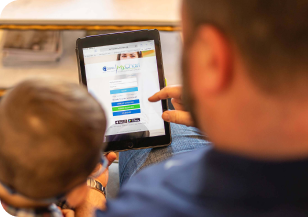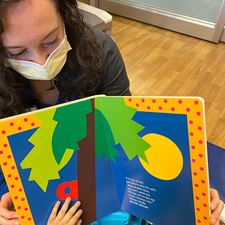GIVE NOW before 2025 ends—your gift will be doubled to help children in need. Click here to 2x your impact!

Ranked nationally in pediatric care.
Arkansas Children's provides right-sized care for your child. U.S. News & World Report has ranked Arkansas Children's in seven specialties for 2025-2026.

It's easier than ever to sign up for MyChart.
Sign up online to quickly and easily manage your child's medical information and connect with us whenever you need.

We're focused on improving child health through exceptional patient care, groundbreaking research, continuing education, and outreach and prevention.

When it comes to your child, every emergency is a big deal.
Our ERs are staffed 24/7 with doctors, nurses and staff who know kids best – all trained to deliver right-sized care for your child in a safe environment.

Arkansas Children's provides right-sized care for your child. U.S. News & World Report has ranked Arkansas Children's in seven specialties for 2025-2026.

Looking for resources for your family?
Find health tips, patient stories, and news you can use to champion children.

Support from the comfort of your home.
Our flu resources and education information help parents and families provide effective care at home.

Children are at the center of everything we do.
We are dedicated to caring for children, allowing us to uniquely shape the landscape of pediatric care in Arkansas.

Transforming discovery to care.
Our researchers are driven by their limitless curiosity to discover new and better ways to make these children better today and healthier tomorrow.

We're focused on improving child health through exceptional patient care, groundbreaking research, continuing education, and outreach and prevention.

Then we're looking for you! Work at a place where you can change lives...including your own.

When you give to Arkansas Children's, you help deliver on our promise of a better today and a healthier tomorrow for the children of Arkansas and beyond

Become a volunteer at Arkansas Children's.
The gift of time is one of the most precious gifts you can give. You can make a difference in the life of a sick child.

Join our Grassroots Organization
Support and participate in this advocacy effort on behalf of Arkansas’ youth and our organization.

Learn How We Transform Discovery to Care
Scientific discoveries lead us to new and better ways to care for children.

Learn How We Transform Discovery to Care
Scientific discoveries lead us to new and better ways to care for children.

Learn How We Transform Discovery to Care
Scientific discoveries lead us to new and better ways to care for children.

Learn How We Transform Discovery to Care
Scientific discoveries lead us to new and better ways to care for children.

Learn How We Transform Discovery to Care
Scientific discoveries lead us to new and better ways to care for children.

Learn How We Transform Discovery to Care
Scientific discoveries lead us to new and better ways to care for children.

When you give to Arkansas Children’s, you help deliver on our promise of a better today and a healthier tomorrow for the children of Arkansas and beyond.

Your volunteer efforts are very important to Arkansas Children's. Consider additional ways to help our patients and families.

Join one of our volunteer groups.
There are many ways to get involved to champion children statewide.

Make a positive impact on children through philanthropy.
The generosity of our supporters allows Arkansas Children's to deliver on our promise of making children better today and a healthier tomorrow.

Read and watch heart-warming, inspirational stories from the patients of Arkansas Children’s.
Hello.

Arkansas Children's Hospital
General Information 501-364-1100
Arkansas Children's Northwest
General Information 479-725-6800


The Work of Play
A Day in the Life of an Arkansas Children's Child Life Specialist
Published date: March 24, 2023
Updated date: April 24, 2024
Coordinating Care
Every day is different in the hospital. New patients enter, and others are discharged. Even for those young children undergoing longer-term care - like many in the ITU - individual needs change as they prepare for or respond to treatments. Luther's shift begins by coordinating with the nurse in charge and reviewing the status of all the patients in the ITU. She then creates a plan for visiting specific patients and coordinates when hospital volunteers will spend time with patients.Making the Rounds
With a plan in place, Luther begins visiting patients. Child life specialists support both the children and their caregivers. In the ITU, it's common for an infant to be connected to a machine that helps them breathe, and the parents may be nervous about jostling the machinery or tubes."Sometimes medical equipment can be intimidating to parents, making interacting with the baby a little scary," Luther said. "My job is to normalize this equipment and help support healthy bonding, coping and development."
Giving caregivers a basic understanding of how the machines work helps ease nerves. Fostering a calm environment helps set the stage for learning and makes patients and caregivers more receptive to treatments.
Play with Purpose
 When Luther does an activity like coloring or playing with a patient, she often has more than fun in mind. Infants need specific exercises to help their bodies and brains grow. Child life specialists provide those activities for young children confined to the hospital.
When Luther does an activity like coloring or playing with a patient, she often has more than fun in mind. Infants need specific exercises to help their bodies and brains grow. Child life specialists provide those activities for young children confined to the hospital. "It is my job to engage them in play that will provide opportunities for developmental stimulation to help them reach developmental milestones. Some of these interventions include tummy time, practicing sitting up, reading books or singing together!"
As the patients get older, the activities are modified to fit the age and ability of the patient. Luther may teach a toddler how to walk or use a doll as a comforting tool to help explain medical terms like peripherally inserted central catheter (PICC) line or tracheostomy.
“This helps give caregivers a basic understanding which allows them to retain more in-depth information given to them later by other medical team members.”
In addition to coordinating activities and volunteers, Luther creates feeding schedules. She helps caregivers stick to the program so their child meets healthy weight goals.
End of Shift
Even the end of a shift is an important opportunity for child life specialists to help patients. Sometimes, the workday ends in a celebration because a patient is being discharged. In those cases, Luther steps into the role of event planner and organizes the party. Whether or not the day ends with the celebration of a patient being discharged, it is still a significant moment. “At the end of the day, I say goodbye to each of my chronic patients to support a therapeutic relationship.”
More About Child Life Specialists
Recognized by the American Academy of Pediatrics and accredited by the Association of Child Life Professionals, our child life team includes certified child life specialists and patient activity specialists. Arkansas Children’s helps train child life specialists through practicum and internship experiences with affiliated colleges and universities.
Learn more about becoming a child life specialist at Arkansas Children’s.
In our Champions Series, we answer the question, “What does it mean to champion children?” by providing a closer look at the daily practices and routines of Arkansas Children’s team members as they help make kids better today and healthier tomorrow.

